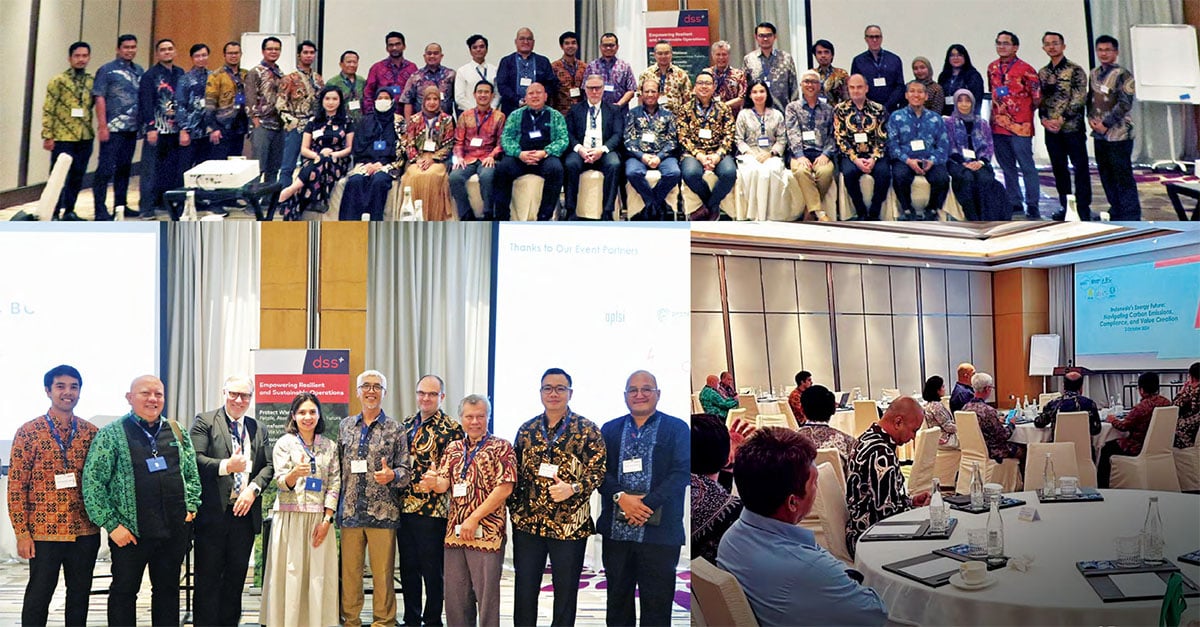Indonesia’s Energy Future: Protect and Create Sustainable Industry Value
Post-Event Publication
A recent roundtable brought together Indonesia’s power sector leaders to discuss a "Two-Speed Model" for risk management in the energy transition, focusing on legacy infrastructure updates and securing capital for new projects, amid challenges in decarbonization and digital transformation. The paper underscores the importance of resilience, innovation, and regulatory alignment in navigating Indonesia’s path to a sustainable energy future.

The Importance of Risk Management
In the context of Indonesia’s power sector, effective risk management emerges as a vital mechanism to plan, protect and prepare the industry to achieve critical goals, Pak Suroso Isnandar – Director of Risk Management at PT PLN (Persero) highlighted this in his keynote address stressing the importance of identifying, quantifying and being prepared to mitigate risks. Some of the key risks discussed during the roundtable included:
Decarbonization
PLN, Indonesia’s national power company, is undertaking a monumental task to add 100 GW of new generation capacity and expand its transmission network by over 70,000 km. However, this expansion comes with significant environmental responsibilities. Currently, the sector emits approximately 320 million tons of CO2 annually. Without strategic interventions, these emissions could escalate to 1 billion tons, posing a severe threat to global climate stability and triggering a real climate emergency. Such unchecked emissions could disrupt ocean currents, affecting ecosystems and livelihoods worldwide.
Digitalization & Decentralization
The transition towards smart grids and decentralized energy systems is reshaping the power landscape. As new technologies emerge, the complexity of operational risks grows. Implementing robust risk management frameworks becomes essential to support innovation whilst concurrently ensuring reliable energy delivery. Stakeholders recognized that navigating this digital transformation requires agility and foresight to manage unforeseen challenges.
Deregulation
With the energy market moving towards deregulation, understanding and managing the associated risks becomes crucial. Stakeholders must ensure energy solutions remain affordable, available, and acceptable to consumers. The intricate challenges posed by a deregulated environment necessitate a proactive approach to risk assessment and mitigation.
During the discussions, participants highlighted that many major accidents result from the cumulative effect of seemingly minor oversights. The recent blackout in Sumatra serves as a stark example, illustrating how lapses in execution can compromise even the most comprehensive plans. This incident emphasized the need for meticulous operational risk assessments, robust mitigation strategies, and fostering a culture of safety within organizations.
Protecting Value with a Two-Speed Model
To address the complexities of the current landscape and safeguard investments, the roundtable introduced a Two-Speed Model designed to enhance operational resilience and efficiency:
Speed 1: Managing Legacy Infrastructure
This speed focuses on the urgent need to manage existing infrastructure, which is being stretched beyond the original design parameters with demands to deliver higher and more reliable output derived from a more distributed and diverse supply base. Participants discussed the challenges of upgrading these systems while ensuring they meet modern technological demands. A key concern is equipping personnel with the skills necessary to navigate new technologies while effectively managing current assets. This risk, can be mitigated by a dual focus on training and technology adaptation to bridge the gap between traditional practices and future needs.
By focusing on installing culture and developing modern technical capabilities, that are able to work in unison with the new expectations set for the legacy infrastructure, organizations will be building RESILIENCE into their operations. In doing so, they will be making output and performance more predictable and less susceptible to potential disruption.
Speed 2: Ensuring Access to Capital and Execution
This component emphasizes the importance of securing capital and fostering an environment conducive to executing projects efficiently. Integrating robust risk management throughout the cycle of deploying capital for new projects will allow organizations to identify potential risks and prepare their responses accordingly. These are organizations that will have better control and assurance that the portfolio of capital projects for new energy will be delivered to meet expectations.
Participants agreed on the critical importance of cultivating a culture of continuous improvement, where safety, efficiency, and waste reduction are prioritized. This proactive approach is essential for maintaining excellence in operational performance.

Current State of GHG Reporting in Indonesia
The discussion turned to the current landscape of greenhouse gas (GHG) reporting in Indonesia, revealing several challenges that must be addressed to strengthen emissions management. Pak Satrio S. Prilianto, Tuv Nord Indonesia shared his experience and insights from certifying the first round of GHG reporting from 2023 in the first quarter of this year:
NEK (Nilai Ekonomi Karbon) and Carbon Pricing
While frameworks for carbon pricing exist, they are not fully functional, hampering effective emissions reduction initiatives. Participants noted the need for more comprehensive regulatory structures to facilitate better compliance and transparency in reporting.
Emission Trading Systems
Examples such as PTBA on SPEI (Sertifikasi Pengurangan Emisi Indonesia) highlight the complexities of establishing a robust carbon market. Stakeholders acknowledged the necessity for a clear emissions cap to quantify reductions effectively, alongside a complementary carbon tax to enhance accountability.
The consensus was clear: for Indonesia’s carbon market to mature, significant enhancements are required. Key missing elements include expanding the carbon market beyond the power sector to include other industries, ensuring a holistic approach to emissions management.
Creating Value in the Power Sector
The conversation shifted towards strategies for creating value within the power sector, emphasizing a holistic approach that incorporates various dimensions:
Access to Capital
Investors today view investment opportunity through multiple lenses.
Investment opportunities are driven by the potential of the commercial returns, but are increasingly gauged against the possible risk they face.
Investment decisions consider the quality of compliance in disclosure and reporting as well as the adoption of ethical business practices. It is incumbent on organizations to address these expectations to attract sustainable investment, making transparency a cornerstone of their strategies.
Operational Excellence
Organization have the foundation in place to PROTECT their business by upgrading the Management Systems, Controls and Processes and building new complimentary capabilities. They should progress to focus on the CREATION of new value from the system; examining how cost might be reduced from across the value chain, how downtime can be reduced, how more initiatives can be done with less and/or indeed how they can offer new improved services to customers. There are opportunities to explore new value from within changing industry.
Innovative Practices
The Energy Transition is demanding the application of new business models that leverage and monetize new technologies. Other categories of innovation will include how companies organize themselves to simultaneous manage the trifecta of risk to the safe operations, risk to predictive and enhanced performance and the risk of not transparently delivering on ESG targets and investments.
New skills enabled by digital will be building blocks of these capabilities but so will innovative new operating structures to align and combine Enterprise Risk Management with Sustainable Operations Risk Management and an capabilities to manage emergencies and crisis when they arise to threaten performance.
Embedding Risk Management in Operations
A significant portion of the discussion focused on the necessity of integrating risk management into everyday operations. Key takeaways included:
Investor Perspectives
Understanding the hurdles faced by foreign investors is critical for fostering a conducive investment environment. Factors such as regulatory alignment and streamlined approval processes significantly influence investment decisions, making it essential for stakeholders to collaborate in creating a more investor-friendly climate.
Regulatory Challenges
The rapidly changing governance landscape presents substantial risks to project stability. Participants emphasized the importance of effective research and development, as well as clear licensing processes, to mitigate complications in project execution.
Real-world examples, such as PLN EPI’s gasification project, illustrated the challenges that can arise from regulatory ambiguities, underscoring the need for streamlined frameworks that facilitate innovation without compromising compliance.
CCUS Technology in Indonesia
The roundtable concluded with an engaging discussion on Carbon Capture, Utilization, and Storage (CCUS) technologies, which are crucial for mitigating CO2 emissions. Pak Dicky Edwin Hindarto and pak TATA SUTARDI, ST., MT., Ph.D provided deep insights in the state of CCUS and other critical innovation in Indoneisa:
Unique Opportunities
Indonesia’s diverse geographical features, including its numerous volcanoes, present significant opportunities for effective CCUS deployment. Stakeholders discussed the potential to harness these resources for sustainable energy solutions that align with global climate goals.
Methodologies for CO2 Management
Participants explored various methodologies for effective CO2 capture, transport, and injection, identifying CO2 injection as the highest risk in implementing CCUS strategies. This critical step involves complex geological assessments and engineering challenges, making it imperative for stakeholders to prioritize research and development in this area. Addressing these technical challenges requires collaborative efforts among stakeholders to develop innovative solutions.
Economic Implications
The economic implications of adopting CCUS technologies could be transformative, offering Indonesia the chance to diversify its energy portfolio while contributing to global emission reduction efforts. The discussions highlighted the importance of a balanced approach that considers both environmental sustainability and economic viability.
Closing Remarks
The roundtable underscored the urgent need for innovative business models that can adapt to the rapidly changing landscape of the power sector. By fostering a culture of collaboration, embracing new technologies, and implementing effective risk management strategies, stakeholders can work together to navigate the challenges ahead and contribute to a sustainable energy future. We aim to continue the conversation in collaboration with our partners and Industry leaders to share best practices and opportunities to accelerate in the energy transition.

Authors





